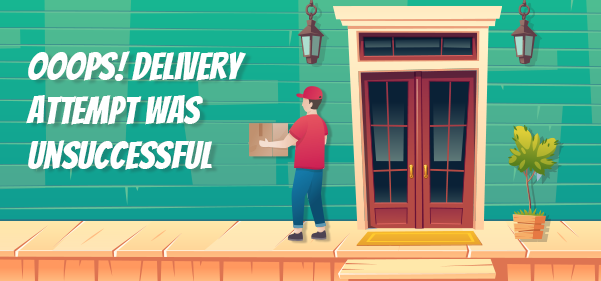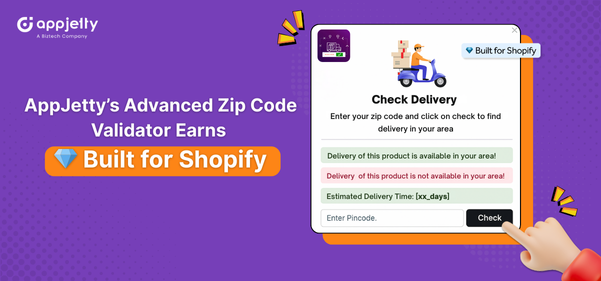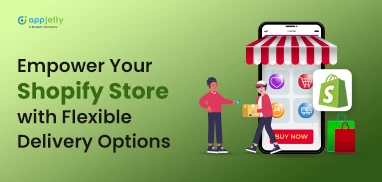Did you know? 24% of e-commerce store owners admit that 1 out of 10 orders is not delivered on the first attempt. Even that first failed delivery attempt can cost retailers a lot of money.
Stats show that for domestic delivery, the first failed delivery attempt can cost retailers an average of $17.20 per order.
There are many reasons for first delivery attempt failures. We have listed down some reasons for this and further explained why it happens and what are the possible solutions.
- Missing the delivery time slot
- Inadequate address
- Damaged package
- Recipient’s unavailability
- Recipient denying to accept the order
You are responsible for the instances apart from the last one. Let’s discuss some of the most common reasons for unsuccessful delivery, even after multiple attempts. We will also discuss what companies do as a solution to these reasons.
4 Common Reasons for Unsuccessful Delivery
1. Recipients’ Absence
The delivery attempt failed because the recipient wasn’t home. There can be multiple reasons this can happen. If you don’t share the delivery date or time information with your customers, they will have no idea when they will receive the parcel.
If the courier service or the brand they ordered from notified them prior to the delivery of the package, they might have planned their day accordingly.
Every company has its own rules and regulations on what to do if no one opens the door.
- The delivery person informs the customers and tries to deliver at a later time, which means multiple delivery attempts.
- Leaving the delivery at the doorstep or sliding it through the door if it’s an envelope. This is a very unsafe option.
- The delivery person can drop off the package in the neighborhood or at a different location.
- The delivery person can take it back to the warehouse or the distribution center, and customers can collect it.
2. Incorrect and Unaccessible Delivery Address
There are times that customers enter incomplete or incorrect addresses. The delivery person can’t find the place in one go, and they might have to contact the customers for the same. Customers might not pick up their calls.
Sometimes, delivery agents are not allowed at the security entrance, or the mailbox is inaccessible for some reason. Again they have to contact the customer, and if they can’t contact them, they have to make multiple attempts or return the product.
3. Unpaid Cash on Delivery
Many customers still prefer cash on delivery as they consider it a safe option. But there are chances that the customer denies to accept the order. They would not agree to pay for the delivery, and the order delivery is considered to be failed.
Many times cash on delivery has an unfavorable impact on the delivery attempts. There can be many reasons for this. Customers might not have cash in hand, so they deny to accept the order, or maybe they just don’t want it anymore.
As a solution, you can notify receipts before the delivery. This will give them some time to keep cash handy. You can also ask your delivery agents to carry a POS machine if customers want to use cards.
4. Undeliverable/Damaged Product
A package that travels a long distance might break or get damaged. Sometimes, poor or insufficient packaging is also one of the reasons. In this case, delivery is not possible. If the delivery person attempts to deliver the package, customers might deny accepting it. This is one more reason for failed delivery attempts.
You can try improving the packaging, especially when you want to transmit it far away or you have something fragile to transmit.
How to Reduce Failed Delivery Attempts
Apart from the first reason discussed above, all the other reasons can be fixed from the company’s end. What a business cannot control is the recipient’s availability. To reduce the number of attempts due to the recipient’s unavailability, businesses can use a tool that asks customers their preferred delivery date. Our Shopify Delivery Date App is one such app. Let us learn more about it.
What is a Scheduled Delivery?
A scheduled delivery is a process of delivering the order on a chosen date. The shipper and customer choose a mutually available delivery date and time, and the shipper ensures delivery within the given timeline.
Types of Shipping Method
To reduce undelivered attempts, you can provide your customers with multiple shopping options. Customers can choose the one they prefer.
1. Local Delivery
Suppose you have a warehouse in city X. In that case, you can have same-day delivery options for customers of city X. Similarly, when you have a warehouse in multiple cities, you can have same-day delivery options for them. Customers will get what they want on the same day. The chances of unsuccessful attempts are quite low in this case.
2. Store Pickup
If you have an offline store, allow your customers to pick up their orders from the store. You do not have to worry about the courier process. Customers will also not have to pay the shipping charge or wait for their order to be delivered. They can simply pick up the order from the store itself. Thus, this shipping method nullifies the chances of unsuccessful delivery attempts.
3. Standard Shipping
In your standard delivery process, ask customers for their preferred delivery date. Rather than deciding which day you will deliver, ask them their preference. They will choose the date they are available. The chances of failed delivery attempts due to unavailable recipients will drastically reduce. There are chances your customers are not available the whole day. You can also ask them to choose from the available time slots. They will choose a time slot when they are present, and you do not have to make multiple delivery attempts to deliver the product.
Shopify Order Delivery Date Manager App
In case you are wondering how you can have multiple shipping options and features to allow customers to choose delivery dates and times, we have an app for you. Shopify store owners can use our Order Delivery Date Manager app to unlock all the above features.
Here are some highlights of what our app offers:
- As discussed above, you can enable multiple delivery options like store pickup, local delivery, and standard shipping.
- Allow customers to choose a date and time of delivery.
- You can handle the available date and time in the backend. Based on the product type, you can keep the gap of a few days to prepare the products. The calendar will block the preparation dates and only allow customers to select the later dates.
- Similarly, for time slots, you can enter the available time slots. You can customize it day-wise. For example, if your delivery agents work a half day on Saturdays, show time slots accordingly.
- Our app allows you to block the days you won’t be working, like weekends, festivals, or any other occasion.
- You can also restrict the number of days for advance orders.
- Additionally, you can also configure the shipping rates on our app. Based on the delivery location, the shipping charges will be added.
- Our app offers two options to choose from for shipping charges: Static and Dynamic
- If you want fixed shipping rates for all the deliveries, you can choose static charges, which will be added to the final amount.
- If you choose the Dynamic option, you can add delivery location and delivery amount for each location. Based on the zipcode, the delivery rate will vary. The respective delivery charge will be added to the final amount.
- You can limit the number of orders you would accept per day.
- We also have Google integration that allows you to view upcoming deliveries.
- You can easily filter the orders by date and have a list of all the deliveries on that day.
What Next!
If you are a Shopify store owner, add advanced features to your store and improve customers’ overall purchase experience.
Customers usually expect the same kind of service that Amazon offers. Not all businesses have such a strong delivery network or multiple warehouses. But you can still give them multiple shipping options. It will help you reduce the number of delivery attempts.
You can subscribe to our monthly/yearly plan. We also provide a free trial if you are unsure how much impact this app can make. Use the trial and opt for the monthly/yearly subscription if you feel satisfied.
All product and company names are trademarks™, registered® or copyright© trademarks of their respective holders. Use of them does not imply any affiliation with or endorsement by them.





